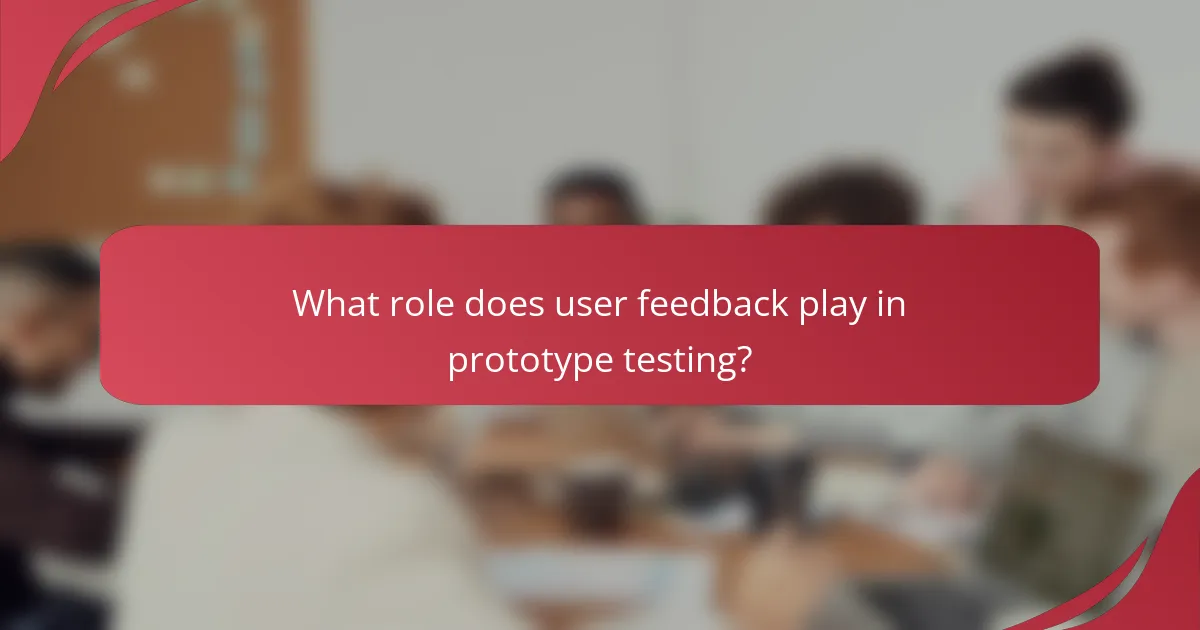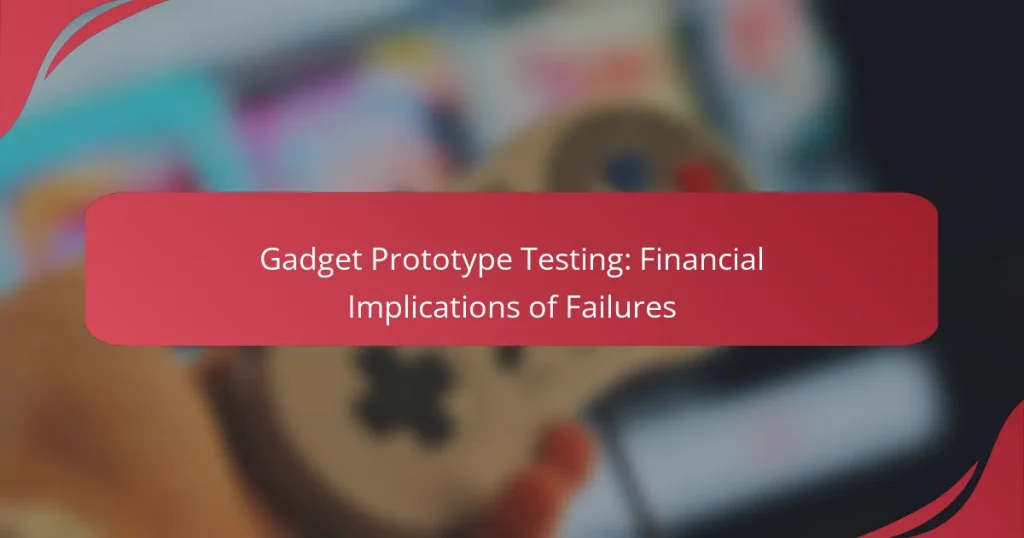Gadget prototype failures can have substantial financial implications, impacting development budgets, market positioning, and investor confidence. By understanding these repercussions, companies can better manage resources and minimize losses. Implementing structured testing processes allows for early identification of potential failures, reducing costs associated with redesigns and delays in market entry.

What are the financial impacts of gadget prototype failures?
Gadget prototype failures can lead to significant financial repercussions, affecting development budgets, market positioning, and investor trust. Understanding these impacts is crucial for managing resources effectively and minimizing losses.
Cost of rework and redesign
The cost of rework and redesign can quickly accumulate when a prototype fails. Companies may need to allocate additional funds for materials, labor, and time to address design flaws or functionality issues. This can result in expenses that exceed initial projections, often leading to budget overruns.
For instance, if a gadget requires multiple iterations to meet performance standards, the costs can escalate into the thousands of dollars, especially if specialized components are involved. It’s essential to budget for potential redesigns early in the development process to mitigate financial strain.
Loss of market opportunity
When a gadget prototype fails, the resulting delays can lead to a loss of market opportunity. Competitors may seize the chance to launch similar products, capturing market share and customer interest. This can diminish the original company’s potential revenue and brand visibility.
For example, if a tech company plans to release a new device during the holiday season but faces delays due to prototype failures, they may miss out on significant sales, which could amount to hundreds of thousands of dollars in lost revenue.
Impact on investor confidence
Failures in gadget prototypes can negatively impact investor confidence, leading to reduced funding or support for future projects. Investors often seek assurance that a company can deliver successful products on time and within budget. Prototype failures can raise concerns about management capabilities and strategic direction.
To maintain investor trust, companies should communicate transparently about challenges and demonstrate proactive measures to address issues. Regular updates and clear timelines can help reassure stakeholders of the company’s commitment to improvement.
Increased production costs
Prototype failures can lead to increased production costs when adjustments are required before mass manufacturing. If a design flaw is identified late in the process, it may necessitate changes to production lines or materials, driving up costs significantly.
For example, if a company must switch suppliers for a critical component due to a prototype issue, the new supplier may charge higher rates, impacting overall production expenses. Companies should consider potential production costs during the prototype phase to avoid unexpected financial burdens.
Potential legal liabilities
Failures in gadget prototypes can expose companies to potential legal liabilities, especially if the product poses safety risks or violates regulations. If a prototype leads to consumer harm or breaches industry standards, the company may face lawsuits or regulatory penalties.
To mitigate these risks, companies should conduct thorough testing and adhere to relevant safety and compliance standards throughout the development process. Investing in legal counsel and risk management strategies can help protect against costly legal repercussions.

How can companies mitigate financial risks in prototype testing?
Companies can mitigate financial risks in prototype testing by implementing structured processes that identify potential failures early. This proactive approach helps in minimizing costs associated with redesigns and market delays.
Implementing thorough testing protocols
Establishing comprehensive testing protocols is essential for identifying issues before they escalate. Companies should create a checklist that includes functionality, durability, and safety tests, ensuring that all aspects of the prototype are evaluated. Regular updates to these protocols based on previous failures can enhance their effectiveness.
For example, a tech company might conduct stress tests on a new gadget to determine its limits. By identifying weaknesses in the prototype, they can make necessary adjustments before launching it to the market, thus avoiding costly recalls.
Utilizing simulation software
Simulation software allows companies to model their prototypes in a virtual environment, reducing the need for physical testing. This approach can save time and resources by identifying design flaws early in the development process. Many firms use software that can simulate user interactions, environmental conditions, and stress factors.
For instance, automotive manufacturers often use simulation tools to test vehicle prototypes under various driving conditions, which helps in refining designs without incurring the costs of building multiple physical prototypes.
Conducting market research
Conducting thorough market research is crucial for understanding consumer needs and preferences before launching a prototype. This research can include surveys, focus groups, and analysis of competitors’ products. By gathering insights on what potential users value, companies can tailor their prototypes accordingly.
For example, a company developing a wearable device might discover through market research that users prioritize battery life over additional features. This insight can guide design decisions, reducing the risk of launching a product that fails to meet market expectations.
Engaging with user feedback
Engaging with user feedback throughout the prototype testing phase can significantly reduce financial risks. By involving potential customers early, companies can gather valuable insights that inform design improvements. This feedback loop helps ensure that the final product aligns with user expectations.
For instance, a software company might release a beta version of their application to a select group of users. The feedback received can highlight usability issues that, if addressed early, can prevent costly revisions after the full launch.

What are the best practices for effective gadget prototype testing?
Effective gadget prototype testing involves systematic approaches to identify flaws and optimize functionality before market release. By implementing best practices, developers can minimize costly failures and enhance product quality.
Establishing clear testing objectives
Clear testing objectives are essential for guiding the prototype evaluation process. Define specific goals such as performance metrics, user experience benchmarks, and compliance with industry standards. This clarity helps focus efforts and resources on critical areas that impact the gadget’s success.
For instance, if a gadget is intended for outdoor use, objectives might include durability against weather conditions and battery life under various temperatures. Establishing these parameters early ensures that testing aligns with user expectations and market needs.
Utilizing agile development methodologies
Agile development methodologies promote flexibility and responsiveness during the testing phase. By breaking the prototype into smaller, manageable components, teams can test and iterate quickly based on feedback. This approach allows for rapid adjustments and refinements, reducing the risk of significant failures later in the development cycle.
For example, using sprints to focus on specific features enables teams to gather user feedback and make necessary changes within weeks rather than months. This iterative process fosters continuous improvement and helps identify potential issues early.
Incorporating iterative testing phases
Iterative testing phases are crucial for refining prototypes through repeated cycles of testing and feedback. Each phase should involve assessing the gadget against established objectives, gathering user input, and making adjustments. This method not only enhances product quality but also builds a deeper understanding of user needs.
Consider implementing at least three to five iterations, with each cycle focusing on different aspects such as usability, functionality, and performance. This structured approach allows teams to systematically address issues and validate improvements, ultimately leading to a more robust final product.

What role does user feedback play in prototype testing?
User feedback is crucial in prototype testing as it provides insights into how real users interact with a product. This feedback helps identify strengths and weaknesses, guiding necessary adjustments before full-scale production.
Identifying user needs and preferences
Gathering user feedback during prototype testing allows developers to pinpoint specific needs and preferences of their target audience. Engaging users through surveys, interviews, or usability tests can reveal what features are most desired and which aspects may be overlooked.
For example, if a gadget prototype lacks intuitive controls, users may express frustration, indicating a need for a more user-friendly interface. This direct input helps prioritize features that enhance user satisfaction.
Improving product usability
User feedback is vital for enhancing product usability, as it highlights areas where users struggle. Observing users interact with a prototype can uncover usability issues that may not be apparent to developers.
For instance, if testers frequently encounter difficulties navigating a device’s menu, developers can refine the layout or streamline the process. This iterative feedback loop ensures that the final product is more accessible and enjoyable to use.
Reducing the risk of failure
Incorporating user feedback significantly reduces the risk of product failure by addressing potential issues early in the development process. By understanding user concerns and preferences, developers can make informed decisions that align with market demands.
For example, if feedback indicates that a feature is unnecessary or confusing, it can be modified or removed before launch, saving time and resources. This proactive approach minimizes costly revisions and enhances the likelihood of market success.

How do financial implications vary across different industries?
The financial implications of gadget prototype failures differ significantly across industries due to varying levels of investment, regulatory requirements, and market expectations. Understanding these differences is crucial for managing risks and making informed decisions during the development process.
Consumer electronics industry
In the consumer electronics industry, prototype failures can lead to substantial financial losses, often ranging from thousands to millions of dollars. Companies invest heavily in research and development, and a failed prototype can delay product launches, resulting in lost market share and increased costs.
To mitigate risks, firms should conduct thorough market research and user testing before finalizing designs. Implementing agile development practices can also help in quickly identifying and addressing issues, reducing the financial impact of failures.
Automotive industry
The automotive industry faces unique financial implications due to the high costs associated with safety regulations and compliance standards. A prototype failure can not only lead to direct financial losses but also result in costly recalls and legal liabilities, which can escalate into millions of dollars.
Automakers should prioritize rigorous testing and adhere to industry standards such as ISO 26262 for functional safety. Early-stage simulations and real-world testing can help identify potential failures before they escalate, minimizing financial repercussions.
Healthcare technology sector
In the healthcare technology sector, prototype failures can have severe financial and ethical implications. The costs associated with regulatory compliance, such as FDA approval in the United States, can be significant, and failures can delay market entry, impacting revenue streams.
To navigate these challenges, companies should engage in extensive validation and verification processes early in development. Collaborating with healthcare professionals during the prototype phase can provide valuable insights, reducing the likelihood of costly failures and ensuring compliance with stringent regulations.

What are the long-term effects of prototype failures on brand reputation?
Prototype failures can significantly harm a brand’s reputation, leading to diminished consumer trust and potential loss of market share. Over time, repeated failures may create a perception of unreliability, impacting customer loyalty and future sales.
Impact on customer trust
When a prototype fails, it can lead to immediate disappointment among customers, which may erode their trust in the brand. Trust is crucial for customer retention; a single failure can prompt customers to consider alternatives, especially in competitive markets.
For instance, if a tech company releases a gadget that frequently malfunctions, customers may hesitate to purchase future products, fearing similar issues. Brands must work diligently to rebuild trust through transparent communication and effective solutions.
Effects on market positioning
Prototype failures can alter a brand’s market positioning, making it appear less innovative or reliable. This shift can result in a competitive disadvantage, as consumers may gravitate towards brands perceived as more dependable.
To counteract negative perceptions, companies should emphasize their commitment to quality and innovation in marketing efforts. Highlighting improvements and successful product launches can help regain a strong market position.
Long-term financial consequences
The financial implications of prototype failures can be substantial, affecting revenue and profitability. Costs associated with recalls, repairs, and customer compensation can quickly add up, straining budgets and resources.
Additionally, a tarnished reputation may lead to decreased sales, impacting long-term financial health. Brands should consider investing in thorough testing and quality assurance processes to minimize the risk of failures and their associated costs.


